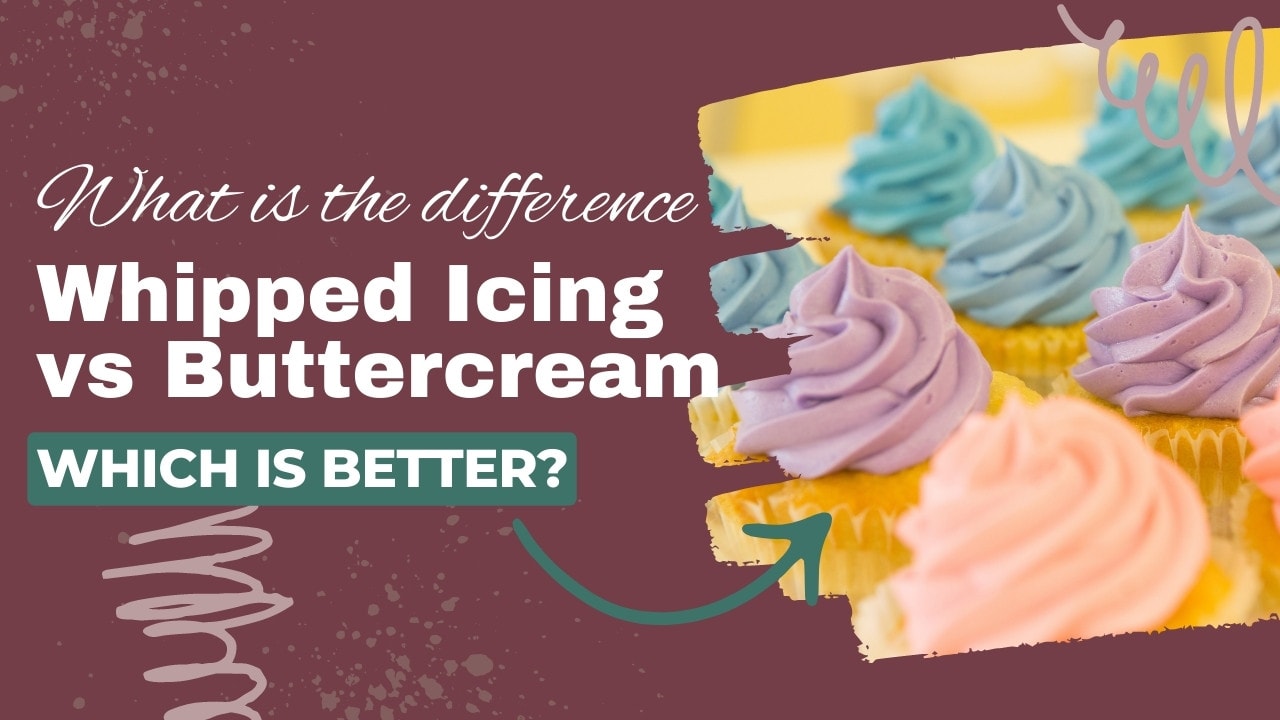When I was in pastry school, one of my favorite classes was the icing class. I spent hours researching, making, and, most importantly, tasting frosting! We studied and perfected two tasty but definitely different types of icing: whipped icing and buttercream.
So, what is the difference between whipped icing and buttercream? And which is better?
I could spend all day talking about frosting, so I’m so excited to discuss all the sugary ins and outs of one of my favorite topics.
Here’s what you’re going to learn in this article:
Whipped Icing vs. Buttercream: Key Takeaways
- Whipped Icing is lighter and airier, made with heavy whipping cream. Whipped icing is ideal for a less sweet, fluffy texture and simple designs.
- Buttercream is richer and thicker, crafted from butter and sugar. Buttercream is suitable for intricate designs and offers a sweeter taste.
- Texture and Taste: Whipped icing is less sweet with a light texture, while buttercream is sweet and firm.
- Usage: Choice depends on the design complexity and flavor preference.
- Shelf Life: Buttercream has a longer fridge life compared to whipped icing.
Each is best suited for slightly different applications, and they have very different shelf lives, so one is not necessarily superior to the other; it all comes down to how you use it.
Remember also that there’s a vast array of frosting or icing recipes across many cultures, and different chefs will use their own names or introduce their own tweaks to these traditional recipes.
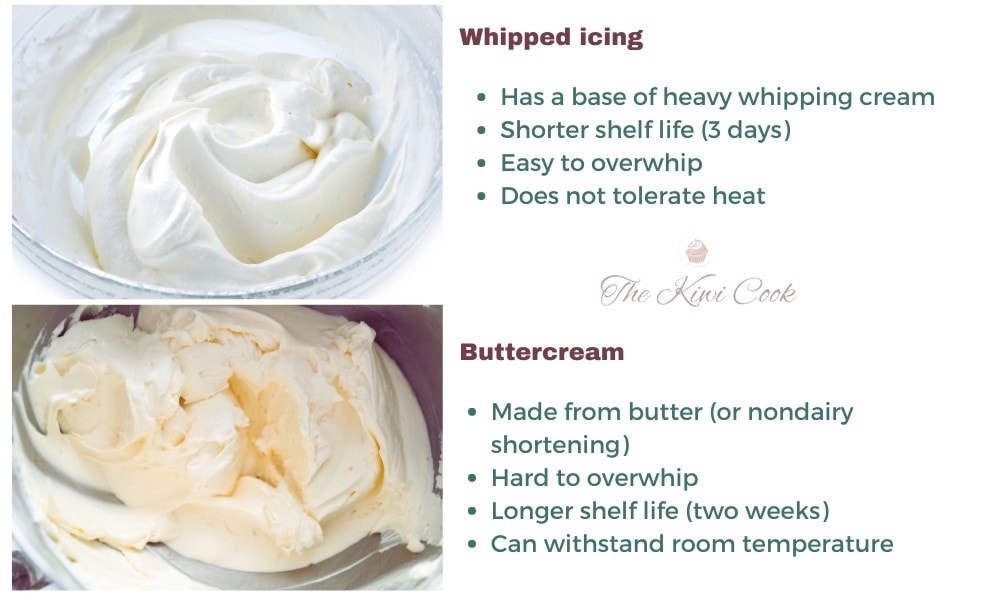
Icing vs Frosting
First, let’s talk about the difference between “icing” and “frosting.” While these two terms are used interchangeably super often, you could point to a difference between them.
Icing can be whipped or not whipped. It can simply be a glaze created with a simple recipe like powdered sugar, lemon juice, and a drop of milk. When icing is whipped, it often has a cream base.
Frosting, on the other hand, is always whipped. It usually has a fat base – such as butter or shortening. In short: Frosting is fluffy. Icing is not – unless it’s whipped icing!
What is Whipped Icing?
Whipped icing, also known as whipped cream icing, is a light frosting made from heavy whipping cream, powdered sugar, flavoring, and cream of tartar. It has a light and fluffy texture and is best used for icing cakes and cupcakes and very simple frosting designs.
You start by whipping the cream to soft peaks before adding the cream of tartar and flavoring. Then sifted powdered sugar is added slowly until the icing reaches stiff peaks. It is essential to get the cream to soft peaks before adding the sugar, or it will be weighed down and won’t achieve the thickness you’re looking for.
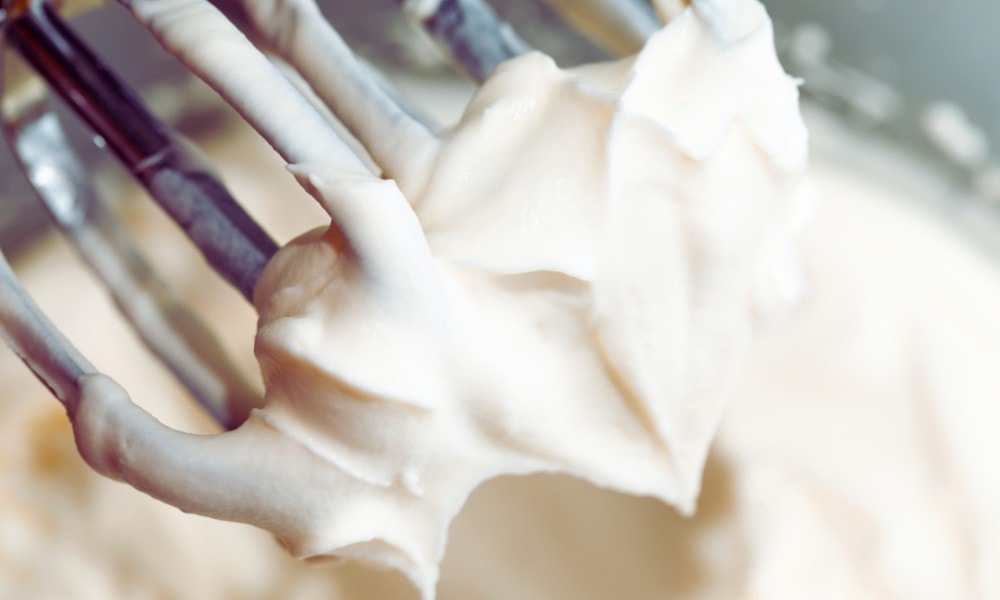
But be careful – if you overwhip the icing it will solidify and you could make butter by accident!
Adding cream of tartar stabilizes the cream and makes it hold its shape; it is also used in meringues for this purpose. The ratio of cream to sugar in whipped icing is 1:2, so it’s not too sweet but still creates a thick texture.
I like making whipped icing by hand using a whisk or hand blender. You can use a stand mixer if you are making large quantities, but you need to keep a close eye on it so you don’t inadvertently overwhip it.
Looking for a recipe? Try our White Christmas Eggnog Chiffon Cake
What is Buttercream?
Buttercream is a popular frosting made from butter (or nondairy shortening), powdered sugar, flavoring, and maybe a little water or milk. It is thick and rich and holds its shape very well. This makes it ideal for icing and filling a cake and piping flowers, borders, and other detailed piping designs. It can also be used to pipe details onto fondant-covered cakes.
To make buttercream, the butter is beaten until soft; then, you add the powdered sugar a little at a time until it is fully incorporated with no lumps. The whipping process incorporates air into the fat particles of your butter and sugar mixture to create a thick yet soft and spreadable consistency.
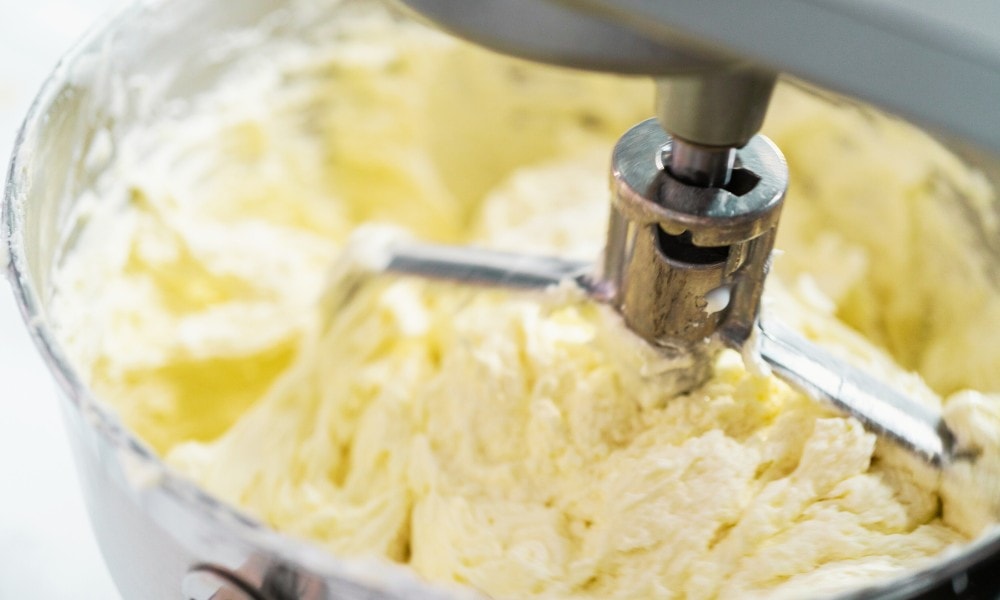
The frosting has a powdered sugar-to-butter ratio of 2:1, which is why this frosting is so sweet. I use salted butter to combat the sweetness and balance out the flavor to the perfect level.
Like whipped icing, you can make the buttercream by hand, but only if you get the butter very soft. Even then, it will take a lot more elbow grease than whipping cream. In my professional opinion, the key to getting light and fluffy buttercream is a good stand mixer. Kenwood is my favorite brand of stand mixer and the one that never let me down in the pastry kitchen, so I highly recommend investing in one of these.
American buttercream usually does not include eggs. Other buttercream styles – Swiss, French, or Itatlian – include eggs and are trickier to master.
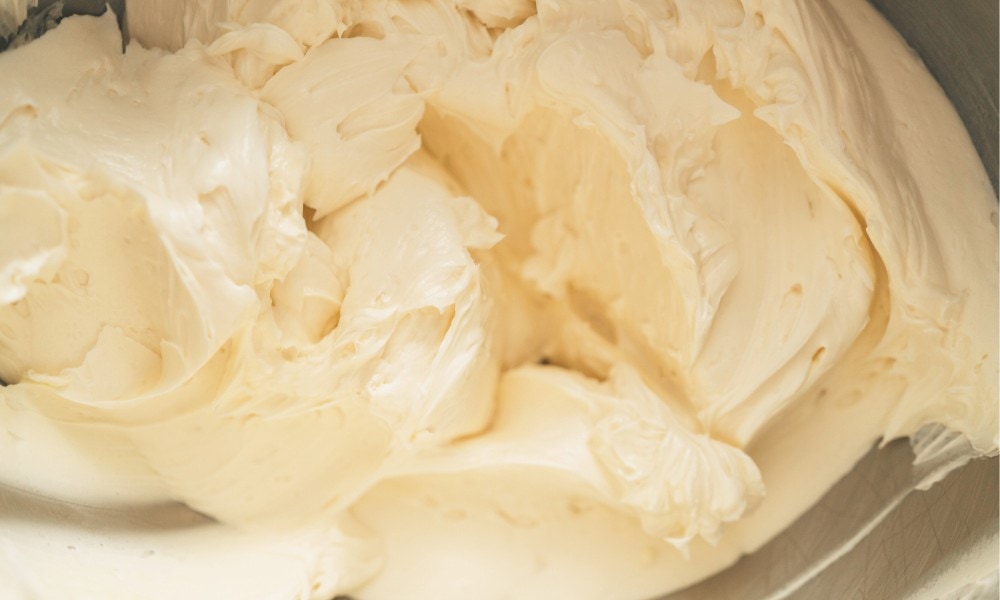
If you are planning to make a buttercream, try our delicious Chocolate Cupcakes with Peanut Butter Cream & Caramel Sauce recipe.
Whipped Icing vs. Buttercream: What’s the Difference?
Let’s compare the whipped icing and buttercream side-by-side and see how they are similar and where they differ:
| Whipped Icing | Buttercream |
|---|---|
| Whipping cream base | Butter or shortening base |
| Sweetened with powdered sugar | Sweetened with powdered sugar |
| Whipped to thicken and aerate | Whipped to loosen and aerate |
| Easy to overwhip | Hard to overwhip |
| Must be refrigerated | Must be refrigerated |
| Shorter shelf life (3 days) | Longer shelf life (two weeks) |
| Does not tolerate heat | Can withstand room temperature |
| Colored with gel or oil coloring | Colored with gel or oil coloring |
| Light and fluffy | Thick and rich |
| Moderately sweet | Very sweet |
In the video above, YouTuber Asia Coffee highlights the fact that, while both of these frostings are made from perishable ingredients, they have very different shelf lives.
Buttercream can last in the fridge for up to two weeks, while whipped icing only lasts three days. This is the main factor that you need to consider when you are choosing your icing, but there are other elements that are almost as important when deciding which of these frostings is better for your project.
Which Frosting is Better: Whipped Icing or Buttercream?
Of course, all frosting is good frosting! You won’t see me turning down a well-frosted cupcake in a hurry, that’s for sure! But different frostings are suited for different applications. Whether whipped icing or buttercream is better depends on what you’re using it for and what finish you want.
Of course, personal taste is also a considerable factor. Some people find buttercream too sweet and find whipped icing an excellent light alternative, while other people revel in the thick indulgence of a delectable buttercream. (Remember, though, if you find American buttercream too sweet, you can try Italian or Swiss buttercream for a happy medium!)
Here are the three main factors to consider when deciding which frosting to make:
Storage and Shelf Life
When I worked as a pastry chef, I made pounds and pounds of buttercream, but not once did I make a batch of whipped icing. And why is that? It’s not only because buttercream performs better when piping it. It’s primarily about shelf life and how it withstands heat.
In a restaurant setting, the whipped icing could not withstand sitting out on the pantry counter for the day without the icing melting, losing its shape, and going sour. This is something to consider if your cake is going to be put out on display for a while before serving. (Though if you use cream of tartar to make stabilized whipped icing, then it will hold up much better.)
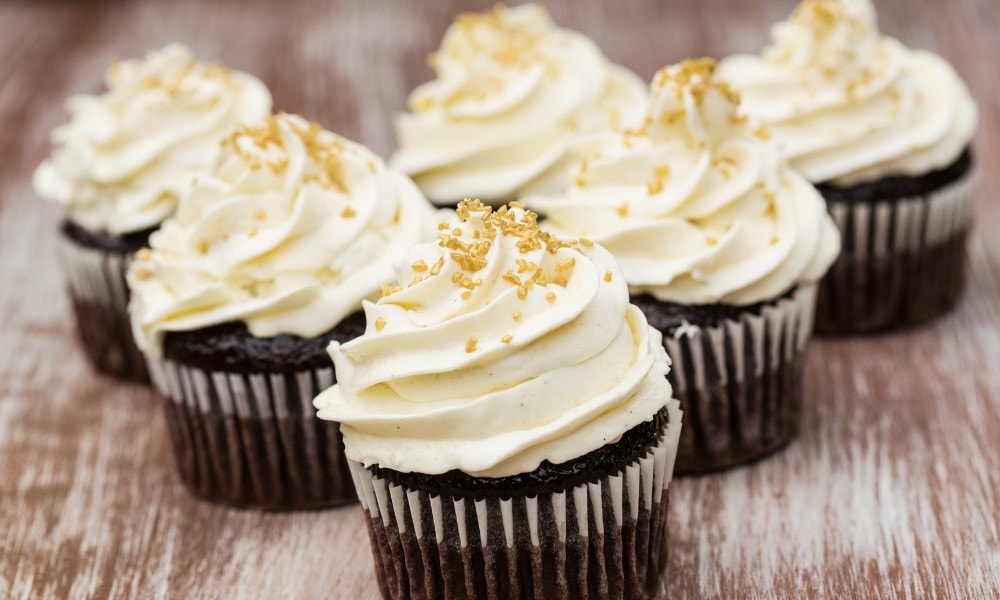
If you’re keeping them for several days, both of these frostings must be stored in the fridge, whether in a container or on the cake. But you can store buttercream for much longer than whipped icing.
This is because of the shelf-life of the base ingredients. Cream, the base of whipped icing, is a natural dairy product separated from milk and packed without any processing besides pasteurization. The shelf life of cream is 7-10 days in the refrigerator – and just an hour or two on the counter.
Butter, on the other hand, is created by beating cream until it separates into butter and buttermilk. After undergoing this process, butter becomes more stable, and the shelf life extends to three months in the fridge and at least a day on the counter!
As I mentioned above, this means that whipped icing only has a shelf life of three days if refrigerated, while buttercream can be stored for two weeks in the fridge.
Texture
The texture of these two frostings is very different from each other. Buttercream is very rich and dense, while whipped frosting is light and fluffy. In my opinion, neither is superior to the other in this case; it really depends on what result you are cooking for in your final cake creation.
You really notice the difference in texture and stability when you take your icing out of the fridge. The buttercream will be very stiff and hard out of the fridge. But since it’s almost impossible to overwork, you can simply pop it in the stand mixer and whip it until it’s spreadable and easy to pipe with!
On the other hand, the whipped icing can very easily be overworked or deflated from extra beating. If you want to regain some more volume after storing it, I recommend beating it lightly with a whisk but do not put it in the mixer!
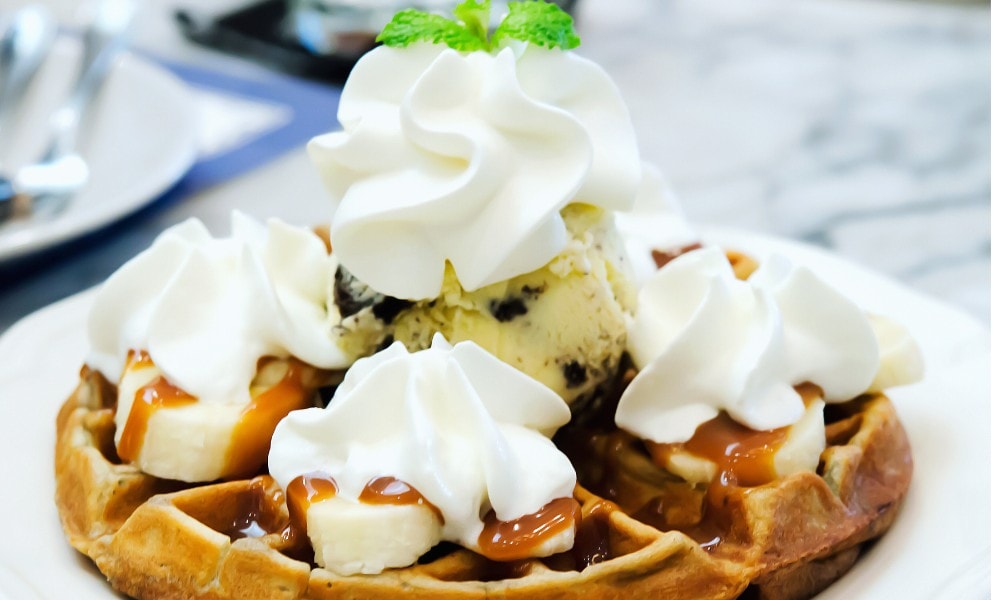
The thickness of buttercream means that it holds its shape very well, even when piping something delicate like roses. If you want to flex your piping muscles and decorate a cake with borders and other designs, then buttercream has the perfect texture for that.
But whipped icing will work just as well if you are simply icing a cake or doing a simple swirl of icing on a cupcake.
In short: buttercream is better for delicate piping work, but whipped icing is fine for a cupcake swirl.
Flavors
While it is possible to add flavorings to whipped icing, it is a little challenging because you are limited to using mainly essences and extracts. Since the base of the frosting is whipped cream, you don’t want to use any ingredient that’s going to knock the air out and deflate it. You can use cocoa powder to make chocolate whipped icing, but you must get the ratio right.
On the other hand, Buttercream is a much firmer and more stable base to work with. When flavoring buttercream, you can use essences, extracts, fruit purees, cocoa powder, and even caramel and whip them into the frosting.
Conclusion
Whipped icing and buttercream are two delectably delicious frostings that every home pastry chef should have in their repertoire. Neither is clearly superior to the other; it all depends on how you’re using your icing and which one suits your tastes. Happy frosting!

